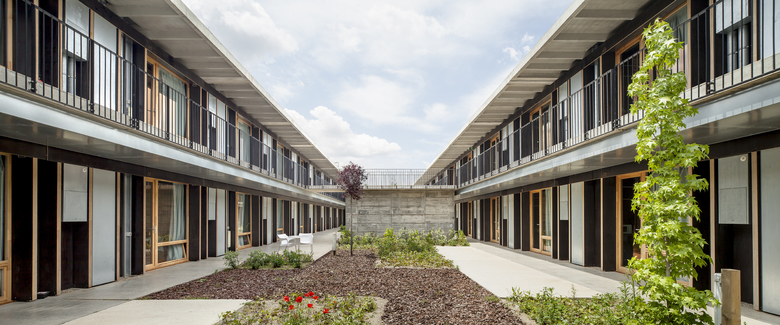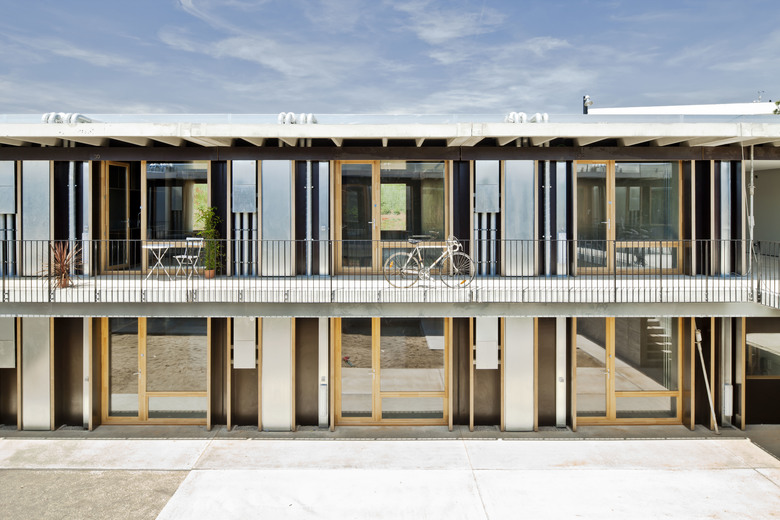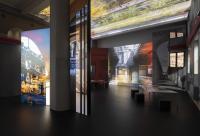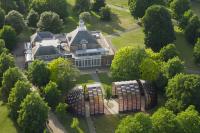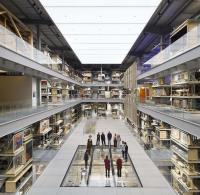Dwelling house for students
Sant Cugat del Vallès, Barcelona, Spain
The new dwelling house for students is placed in the same plot as the University of Architecture (ETSAV), in a low density residential area in Sant Cugat del Vallès. The competition, organized by the ETSAV and the UPC, considered three ambitious challenges: to built a housing area for architecture students, to comply with the Swiss energetic certification Minergie (below 38kwh/m2a) and to use a new system of industrialized construction (EMI System by Compact Habit).
The position of this new building aims to maintain the balance between the existing buildings and outdoor spaces as well as prioritizing the direct connection between housing and campus with the ground floor, promoting the use of outdoor spaces and the horizontal pathways, adapted and without lifts. The existing topography and its own double parallel block organization allows dwelling to be closer to the ground level and to favour a big central atrium, where, as a living room, the community life will take place. A new space that gives to the dwelling house and campus 1000m2 of non-expected community spaces.
The residency program for architecture students allows to imagine deep relationships between users, , both individual, due to the housing unit flexibility, and collective, thanks to the potential use of the central atrium as a social event space.
We soon realized there was no need to distribute the unit typology considering that students, researching, using and developing themselves over the years, would find the maximum potential at 40m2 space. Our proposal tries to determine as little as possible the unit typology bordering the habitability limits and only offering those elements required by regulation. In this way we try not to completely finish the housing, opening new fields of opportunity: more freedom in the appropriation of the space by the architect student, material cost saving in finishing reinvested in energetic efficiency and a more real and pedagogical expression of construction.
The use of a industrialized system has been decisive for the project development and it has positively conditioned to many decisions related to optimization and rationalism of the industrial process. The project accepted from the beginning the industrialized construction rules opting for a single prefabricated housing model and constructive systems in line with a workshop assembly, trying to use this industrial logic as far as possible. Industrialization allows to save time, a better execution control guaranties, to implant new dry construction systems and to minimize the production of waste materials during the construction process. It was a great opportunity in design and sustainability terms.
62 unit modules are built, 57 of which are the same typology and the rest are special units destined for community uses and access. One of the advantages of industrialized construction lies in the execution times due to the fact that construction process can be faster in material execution and in addition, it allows the realization of simultaneous tasks in workshop and on site at the same time. The construction time was developed in the next stages: - 2 months: on site works (foundations, sewage, general installations…) - 2 months: units manufacturing in workshop - 2 weeks: transporting and assembling the units on site - 3 months: general finishing (roof top, façade details, urbanization…)
The idea of a 'non finished' building has a decisive influence in the material result of the building. On the one hand, it proportionally reduces the environmental impact due to the fact that less material resources are used for the same function. On the other hand it offers you the opportunity of a new, more direct and sincere, way of material expression where building construction appears much clearly. The original concrete module appears mostly naked, taking positively profit of its materiality, its texture and its thermal inertia. The few interior finishings added are mainly formed by plywood panels often used for the concrete formwork having the advantage of being a renewable and dry joint material and with no finishing need. The kitchen cupboard, made in the same material, have been designed without doors but with a lot of mobile shelves, allowing not only to economize the construction but also allowing students to express the real use of the house in a better way. Installations are exposed, when possible, in a way to make a teaching implementation. The façade technology uses a dry construction logic, light and reversible, where an important thermal isolation thickness combined with a breathable and water tightness membrane, and a ventilated façade system are predominated. Exterior façades, much more exposed to the outdoor weather conditions, have been resolved using galvanized folded sheets reducing the weight and quantity of no renewable material. On the other hand, on the interior façades, more protected, the same plywood panels have been used. The economic savings achieved by using this kind of materials, have been invested in an energetic efficiency improvements ( more isolation, better glazing, wooden windows...)
Some of the industrialized systems have a greater environmental impact (energy consumption, generation of waste materials and CO2 emissions) than conventional construction. But in this case, using a closed life-cycle materials criteria (less material used by service unit, recycled and recyclable materials, dry and reversible joints, more durability of the structure), a significant lower environmental impact has been verified: this project saves up to 25% CO2 emissions in manufacturing process, 50% waste materials in the assembly stage and 75% waste materials in the deconstruction stage.
Once the lifetime building is over it could be completely disassembled, concrete modules as almost all elements and systems could be reused; the building will be no longer a product to become a resource once again. Possibly, recyclable and reuse processes are the most strong concept of the modular system. Its assembly system with no rigid and completely disassembled joints allow us to imagine a future reuse of the concrete module in another buildings and situations. Although the project has positioned on a systematic use of a single typological module, it has been tried to soften this repetition and serial perception by fragmenting and superimposing the different constructive elements that organize the façade in a smaller and more typical of a constructive components and its functions. Double skin also achieves a more inclusive expression of the totality by superimposing another layer, a new vegetal, organic and changing language that finds its formal composition in a solar protection function.
The project does not try to show an industrial modular system but optimizing and integrating a modular logic inside of a technology and habitability collage.
- Arquitectos
- H Arquitectes
- Localização
- Sant Cugat del Vallès, Barcelona, Spain
- Ano
- 2012





